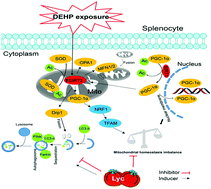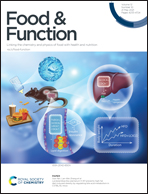Lycopene attenuates di(2-ethylhexyl) phthalate-induced mitophagy in spleen by regulating the sirtuin3-mediated pathway†
Abstract
Lycopene (Lyc) has been discussed as a potential effector in the prevention and therapy of various diseases. Di(2-ethylhexyl) phthalate (DEHP) is regarded as a universal environmental pollutant. To clarify the potential protective effect of Lyc on DEHP-induced splenic injury, 140 male mice were randomized into seven groups: control (distilled water), vehicle control (corn oil per day), Lyc (5 mg per kg BW per day), DEHP (500 or 1000 mg per kg BW per day), and DEHP combined Lyc group, respectively. All experimental animals were treated by oral gavage for 28 days. The results that showed DEHP exposure significantly up-regulated the mRNA and protein expression of the sirtuin family (except SIRT4-5), PGC-1α, OPA1, Drp1, MFN1/2, NRF1, TFAM, Parkin and PINK in DEHP-treated alone groups and the SOD2 and LC3-II protein expression were also in accordance with the above changes. These were accompanied with an increase of the number of inflammatory cells and rate of mitochondrial damage, and autophagosome formation in the spleen. Notably, Lyc supplementation facilitated all these changes to effectively return to the normal level, indicating that Lyc exerts protective effects against DEHP-induced splenic toxicity. Altogether, the protective effects of Lyc may be a strategy to ameliorate DEHP-induced spleen damage.



 Please wait while we load your content...
Please wait while we load your content...